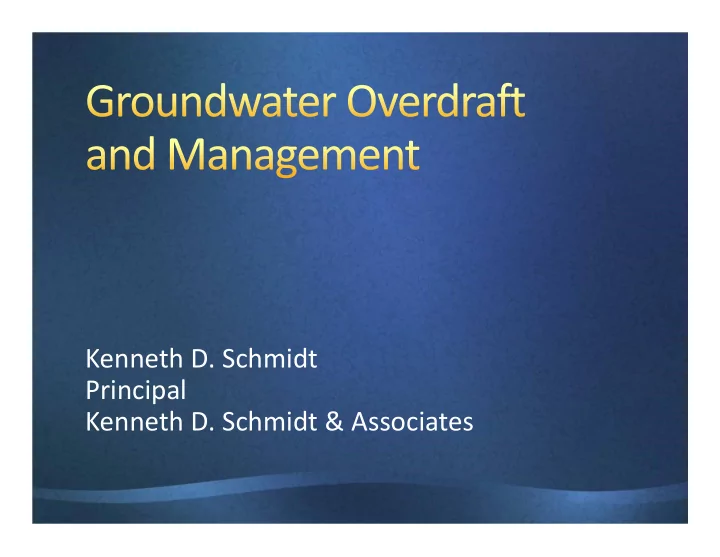

Kenneth D. Schmidt Principal Kenneth D. Schmidt & Associates
Sources of Inflow Amount (AF/yr) Streamflow Seepage ______________ Canal Seepage ______________ Deep Percolation from Irrigation ______________ Groundwater Inflow ______________ Intentional Recharge ______________ Subtotal: ______________ Sources of Outflow Amount (AF/yr) Pumpage ______________ Groundwater Outflow ______________ Subtotal: ______________ Change in Storage: Inflow minus Outflow = ______________
Water ‐ level change (ft/yr) × specific yield (%) × Area = _____ (AF/yr) Specific yields commonly range from 10 to 20% For unconfined aquifers only.
Stanislaus Merced Fresno Kings Kern
Early 1970’s Basin 5D 2 million acre ‐ feet per year Projected 2000 Basin 5D 1.3 million acre ‐ feet per year 2009 (USGS PP 1760) Central Valley 1.3 million acre ‐ feet per year Present San Joaquin Valley 1.5 to 2.0 million acre ‐ feet per year
Consumptive Use of Applied Water = ___ % Applied Water Low Values: 40 to 50% High Values: 90% Depends on topsoils and method of irrigation Commonly: 80 to 90% for drip irrigation 65 to 70% for sprinkler irrigation 40 to 50% for furrow and basin irrigation
Low irrigation efficiencies in areas with surface water supplies resulted in large amounts of recharge of low salinity water, spread out over large areas. High irrigation efficiencies result in less recharge from irrigation and higher increases in salinity for the shallow groundwater.
Compare the amount of surface water available to the consumptive use of applied water. If the surface water is greater than the consumptive use, water levels will rise and there will normally be groundwater outflow. If the surface water is less than the consumptive use, water levels will fall and groundwater inflow will be enhanced. If the surface water and consumptive use are equal, groundwater levels will be stable. The groundwater aquifer should be considered a storage space for surface water, and not a source of water supply itself.
One interpretation: If one has no surface water and is not next to a river that is a losing stream, then all of the groundwater pumpage is generally not sustainable. The only sustainable groundwater pumpage is where there is adequate surface water to balance the consumptive use, unless there is sustainable groundwater inflow to create a balance.
Use Darcy’s Law: Q = T I L Q: amount of groundwater flow T: transmissivity I: hydraulic gradient L: width of flow “I” is determined from shallow and deep zone groundwater maps. “T” is determined from aquifer tests. Note: Groundwater modeling is not considered an accurate approach to determine transmissivity.
Recommend
More recommend